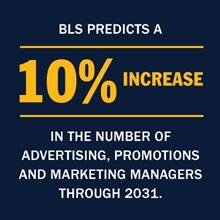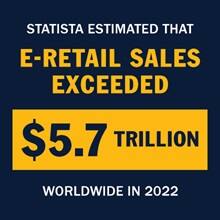From SEO to Social Media: What Are the 8 Types of Digital Marketing?

Understanding the Numbers
When reviewing job growth and salary information, it’s important to remember that actual numbers can vary due to many different factors — like years of experience in the role, industry of employment, geographic location, worker skill and economic conditions. Cited projections do not guarantee actual salary or job growth.
In the past decade, digital marketing has become a vital component in an organization's overall marketing strategy. It allows companies to tailor messages to reach a specific audience, making it possible to market directly to people who are likely to be interested in their product.
One academic team member from Southern New Hampshire University (SNHU) spoke about how digital marketing aligns with traditional tactics and shared information on some of the types of digital marketing in practice now.
What is Digital Marketing in Simple Terms?

A senior associate dean of business programs at SNHU, Dr. Jessica Rogers, said digital marketing requires marketing savvy, strategic thinking and handling a great deal of data. It's based on many of the principles familiar to traditional marketers and requires both foundational knowledge and technical know-how.
According to Rogers, the two disciplines serve to connect with distinct groups of consumers. “Traditional media is a great way to reach a broad consumer base, whereas digital media has the ability to reach very specific audiences,” she said. “A key point is that depending on the target audience, some channels are more effective than others.”
Learn more about the fundamentals of digital marketing.
What Are the 8 Types of Digital Marketing?
Rogers talked about some of the most popular types of digital marketing, providing a brief overview of each:
1. Affiliate Marketing
With the increased prominence of online marketing, affiliate marketing — also known as influencer marketing — has become popular among many organizations in bridging the gap between consumers and organizations. But what is affiliate marketing?
Affiliate marketing utilizes the ever-growing popularity of industry experts and social media influencers. In working with these third-party influencers, your organization will collaborate to promote your products or services for compensation. In collaboration, influencers will engage their audience with posts, blogs or videos to bring in more business for your organization and create new leads.

The job market is growing for marketers. The U.S. Bureau of Labor and Statistics (BLS) predicts a 10% increase through 2031 in the number of advertising, promotions and marketing managers.* In 2021, the median salary for those positions was $133,380, according to BLS.*
2. Content Marketing
Content marketing uses storytelling and information sharing to increase brand awareness. Ultimately, the goal is to have readers take action toward becoming a customer, such as requesting more information, signing up for an email list or making a purchase. “Content” can refer to blog posts, resources like white papers and e-books, digital videos, podcasts and much more.
In general, it should first and foremost provide value to the consumer — not just advertise the brand or try to make a sale. Content marketing is about building a sustainable, trusting relationship with your customers that can potentially lead to many sales over time, not just a single transaction.
Content marketing works in symbiosis with other types of digital marketing: It is a way to incorporate search engine optimization (SEO) into fresh website content, and the content created can be shared as social media posts and in email marketing publications. Looking at the analytics for your content marketing can tell you a lot about your customers:
- What are they looking for when they land on your site?
- What kinds of content make them stay on the site longer and keep looking around?
- What kinds make them lose interest and navigate away?
Unlike a method such as PPC, content marketing is a long-term strategy. Over time, marketers build up a library of content (text, video, podcasts, etc.) that will continue to bring users to the site via search engines, according to Adobe Experience Cloud, an organization that specializes in digital experience tools. This content library also helps promote knowledge of your brand and increases your profile as a resource for information.
And, if users are visiting your site for information, ideally they will remember you as an authority when it’s time to make a purchase.
Content marketing is a great avenue for people who enjoy writing and/or video and audio production. But as with digital marketing in general, it also calls for strong strategic and analytic skills.
There are tons of website-building platforms and blogging sites you can use to get into content marketing. For free and low-cost options, you can consider:
- WordPress
- Medium
- Hubspot CMS
- Wix
Some of these tools include features that provide tips on how to incorporate SEO, social media, email marketing, website design and more, so you can get the full digital marketing experience.
3. Email Marketing
Even with the emergence of social media, mobile applications and other channels, email is still one of the most effective marketing techniques, Rogers said. It can be part of a content marketing strategy, providing value to consumers and, over time, converting an audience into customers.
Email marketing pros not only know how to create compelling campaigns, but they also understand optimal audience outreach and are skilled at analyzing customer interactions and data, and making strategic decisions based on that data, according to the American Marketing Association (AMA).
Email marketing software can offer many different analytical measures, but two that marketers are always striving to improve are the open rate — the percentage of recipients who opened the email — and the click-through rate — the number of recipients who opened the email and clicked on a link in the email.
According to leading email marketing software company Constant Contact, there are many things marketers can do to make their emails more appealing to users and more likely to be opened.
These include:
- Create a Sense of Urgency – Writing email copy that lets your recipients know that time is running out to get a special deal or that there are only a limited number of offers available can increase the number of people clicking through to your website.
- Personalize Your Email – Setting your emails and subject lines up to incorporate the recipient’s name is a proven way to increase open and click-through rates. (A sample subject line: “Katie, a special offer just for you.”)
- Let Recipients Set Their Preferences – Allowing users to specify how often they want to hear from you can help keep some of your email subscribers subscribed to your list and clicking on your emails.
4. Marketing Analytics
One of the major advantages of digital marketing is that it is highly trackable and measurable. Once, the only trackable marketing pieces were coupons and similar direct mail offers. If a customer used the coupon, you knew the message resonated.
Today, analytics allow marketers to track user behavior at a highly detailed level:
- How many times they click on a link
- How much time they spend on a web page
- How often they open emails and much more
But the vast amount of information available about digital marketing performance can feel like drinking from a fire hose, and marketers must be able to truly understand what the data mean and how they should inform strategy.
Not only does this allow marketers to learn what is successful with consumers and adapt their marketing messages moving forward, it also means they can demonstrate their value to the company. Understanding all of this data and using it to make strategic decisions is an important part of a digital marketer’s work — and one that sets them apart from their traditional counterparts.
There are many tools available for measuring the success of digital marketing campaigns, and many marketers will use some combination of these tools, depending on their needs and their audience. One of the most used tools for marketing analytics is Google Analytics, which can be customized in nearly endless ways to measure:
- How your site is performing
- Which keywords are bringing users to your site
- How users are navigating through your website and much more
Having good, accurate analytics and the know-how to interpret them can help marketers “fail fast,” quickly cutting campaigns that aren’t working and building better campaigns around concepts that have a proven track record of success. Over time, you won’t just be using analytics to measure your campaigns — the analytics will also inform and improve your campaigns.
In a digital marketing degree program, you'll study a wide range of issues pertinent to a marketing career path, including marketing plans and strategies, branding, mobile marketing and digital advertising.
5. Mobile Marketing
This digital marketing type is focused on reaching your target audience on their smartphone or tablet. Mobile marketing reaches people through text messages, social media, websites, email and mobile applications. Marketers can tailor offers or special content to a geographic location or time, such as when a customer walks into a store or enters an event.

E-commerce has grown immensely in the last few years, becoming an important part of the global retail world. In 2022, retail e-commerce sales were estimated to surpass $5.7 trillion worldwide, Statista reported.
Marketers know that you need to take your message to where your customers are, and it is very clear: Your potential customers are on their phones.
6. Pay-per-Click (PPC)
Pay-per-click refers to paid advertisements and promoted search engine results. This is a short-term form of digital marketing, meaning that once you are no longer paying, the ad no longer exists. Like SEO, PPC is a way to increase search traffic to a business online.
Pay-per-click can refer to the advertisements you see at the top and sides of a search results page, browsing the web, watching YouTube videos and using mobile apps.
One of the other things that differentiate pay-per-click from SEO is that you only pay for the results. In a typical PPC model like a Google AdWords campaign, you will pay only when someone clicks on your ad and lands on your website. You can spend just about any amount of money on pay-per-click advertising. Some companies may see results from investing just a few hundred dollars, but plenty of large companies spend tens of thousands a month on pay-per-click.
How much it costs to run an ad or promote your search results will depend primarily on how much competition there is for your keywords. High competition keywords (i.e. keywords that many people are searching for and that many sites are trying to be found for) will be more expensive and lower competition terms will likely cost less.
When you set up a pay-per-click campaign, you will also be able to choose whether you want your ad or promoted results to be shown to users all over the world or only within a specific geographic area. If you are marketing a brick-and-mortar business, this ability to tailor by location helps you not waste ad dollars serving ads to users who don’t live anywhere near your business, according to Google Ads.
7. Search Engine Optimization (SEO)
The goal of SEO is to get a business to rank higher in Google search results, ultimately increasing search engine traffic to the business’s website.
To accomplish this, SEO marketers research words and phrases consumers are using to search for information online and use those terms in their own content. According to leading SEO software company Moz's "Beginners Guide to SEO," SEO encompasses many elements, from the words on your web pages to the way other sites link to you on the web to how your website is structured.
So, what are some things that can improve a site’s SEO? It’s important to understand that one of the things that makes SEO challenging is that the answer to this question always depends on search engines and their most current algorithm.
Keeping that in mind, here are a few of the most important things for SEO strategists and marketers, in general, to understand about how SEO works today, according to Moz:
- Content indexing – It is important to allow search engines to clearly “read” what your site content is, by doing things like adding alt text for images and text transcripts for video and audio content.
- Good link structure – It is important that search engines can “crawl” your site structure to easily find all the content on your site. There are many things that an SEO specialist can do to properly format links, URLs and sitemaps to make them most accessible to site crawlers.
- Keywords and keyword targeting – Properly deploying your keywords (i.e. the search terms you want your site to be found for) in your content and headers is one of the fundamental building blocks of SEO. It is no longer good practice to “stuff” your content with as many keywords and keyword variations as possible. Writing high-quality content that uses keywords in the headers and a few times in the crawl-able page content is now considered better practice and will make pages rank better in search results.
8. Social Media Marketing
This includes everything a business does via social media channels. Just about everyone is familiar with social media, but marketers must approach social with an integrated and strategic approach. Social media marketing goes far beyond simply creating posts for social channels and responding to comments.
To be effective, efforts must be coordinated and consistent rather than an afterthought. To help keep posts consistent, there are many online tools available to automate and schedule social media posts, although marketers only should use automation as a tool, not a “set it and forget it” solution. Users will figure it out quickly if there is no real person behind the posts.
Social media marketers should not be in a silo separate from other marketing functions. Social marketers need to work with the company’s wider marketing team to coordinate their message across all platforms, online and off, so that every part of the brand is telling the same story.
A crucial part of social media marketing is analytics. Social media marketers must also be savvy at analyzing the performance of their posts and creating strategies based on that data. It’s important to measure how well your current social media posts are performing before continuing to implement your new strategy.
Statista reports that 86% of industry professionals stated that an increase in exposure to their company was the leading benefit of social media marketing in 2023. Behind that, 76% of companies claimed an increase in traffic to their website was the largest advantage, according to Statista.
There are also several free options to spread your message that go beyond Instagram and Twitter. Some other options include Google My Business, eBay and Facebook Messenger and Marketplace.
In other words, social media marketing is a lot more complicated than managing your personal Facebook or Twitter profile. It requires a blend of creative thinking and objective, data-driven strategy and may be a great fit for professionals who enjoy blending these two disciplines.
Find Your Program
A Need for Marketing Skills
Digital marketers support the wider marketing team and the strategic goals of the whole company by rolling out marketing strategies in the online environment, Rogers said.
Digital marketers strive to be a voice for the customer and how they want to interact with a brand digitally.
“(Marketers) strategically approach the brand’s channels to maximize investments, drive traffic and conversions, as well as manage integrated digital content,” said Rogers.
The need to be where the customers are at all times means that digital marketers have a significant responsibility to be attuned to changes in technology, social media and software.
Technology changes quickly; the hot social media app of today may be all but abandoned by next year, but many of the foundational principles of marketing remain the same.
Today, many employers are requiring experience in Google Analytics, Google and Facebook Ads, HubSpot and Hootsuite, according to Rogers. In a master's in digital marketing program, you'll learn the foundations of tools such as these, exploring and applying them through coursework.
They are also looking for candidates who are proficient in Adobe Creative Suites and have a working knowledge of SEO and keyword research.
However, some important pieces of the marketing puzzle have not changed since the days when companies primarily advertised in print, radio and TV. All marketers need strong communication skills and a strong basis in marketing principles.
Employers include these soft skills with the technology-related proficiencies in job posting requirements, according to Rogers.
"A basic tenant of marketing is communicating a marketing message to a target audience," she said. "... Not only must we communicate with our teammates, but we must be able to communicate to customers, executives and more. These folks are our target audience and without strong communication skills, messages will not be received in the way in which we intended."
A Degree for the Future
And earning your digital marketing degree can help you in different fields outside of digital marketing. SNHU graduate Shannon Hayes ’23 earned her bachelor's degree in marketing with a concentration in digital marketing to give her more knowledge in her career.
She earned her associate degree after high school, had a daughter and established her career, but something was missing.
“As a single mother, I worked hard over the years and managed to build a successful career and raise my daughter,” said Hayes. "Unfortunately, my lack of a bachelor's degree often held me back from job opportunities.”
She knows her degree in digital marketing will provide her with more skills in her work and open new doors.
“I'm happy in my current position, but this degree will give me much more opportunity than I had before,” she said.
Find out if marketing is a good major for you.
Since digital marketing is a rapidly changing space, it is imperative for companies to stay up to date on new and emerging technologies while staying true to the brand and the needs of its consumers, Rogers said. There are many ways that companies do this, some of which are the responsibility of digital marketers, while some of that work is supported by other departments. Regardless of the department involved, all of it is done by way of a very strategic and collaborative approach.
“Staying ahead of the competition has never been more important,” Rogers said. “The landscape for businesses is changing so rapidly that is has become a key strategy to include looking to the competition to help inform your own digital strategy.”
Discover more about SNHU's online digital marketing degree: Find out what courses you'll take, skills you'll learn and how to request information about the program.
*Cited job growth projections may not reflect local and/or short-term economic or job conditions and do not guarantee actual job growth. Actual salaries and/or earning potential may be the result of a combination of factors including, but not limited to: years of experience, industry of employment, geographic location, and worker skill.
Alexa Gustavsen '21 is a writer at Southern New Hampshire University. Connect with her on LinkedIn.
Explore more content like this article

SNHU Spotlight: Jeffrey Harris, MBA Grad

SNHU Spotlight: Luis Polanco, BS in Business Administration Grad

SNHU Spotlight: Lynda Jarrett, BS in Business Administration Grad
About Southern New Hampshire University

SNHU is a nonprofit, accredited university with a mission to make high-quality education more accessible and affordable for everyone.
Founded in 1932, and online since 1995, we’ve helped countless students reach their goals with flexible, career-focused programs. Our 300-acre campus in Manchester, NH is home to over 3,000 students, and we serve over 135,000 students online. Visit our about SNHU page to learn more about our mission, accreditations, leadership team, national recognitions and awards.


